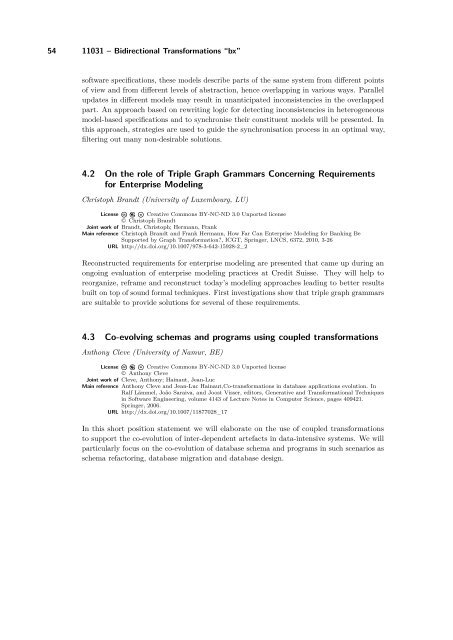Volume 1, Issue 1, January 2011 - DROPS - Schloss Dagstuhl
Volume 1, Issue 1, January 2011 - DROPS - Schloss Dagstuhl
Volume 1, Issue 1, January 2011 - DROPS - Schloss Dagstuhl
Create successful ePaper yourself
Turn your PDF publications into a flip-book with our unique Google optimized e-Paper software.
54 11031 – Bidirectional Transformations “bx”<br />
software specifications, these models describe parts of the same system from different points<br />
of view and from different levels of abstraction, hence overlapping in various ways. Parallel<br />
updates in different models may result in unanticipated inconsistencies in the overlapped<br />
part. An approach based on rewriting logic for detecting inconsistencies in heterogeneous<br />
model-based specifications and to synchronise their constituent models will be presented. In<br />
this approach, strategies are used to guide the synchronisation process in an optimal way,<br />
filtering out many non-desirable solutions.<br />
4.2 On the role of Triple Graph Grammars Concerning Requirements<br />
for Enterprise Modeling<br />
Christoph Brandt (University of Luxembourg, LU)<br />
License Creative Commons BY-NC-ND 3.0 Unported license<br />
© Christoph Brandt<br />
Joint work of Brandt, Christoph; Hermann, Frank<br />
Main reference Christoph Brandt and Frank Hermann, How Far Can Enterprise Modeling for Banking Be<br />
Supported by Graph Transformation?, ICGT, Springer, LNCS, 6372, 2010, 3-26<br />
URL http://dx.doi.org/10.1007/978-3-642-15928-2_2<br />
Reconstructed requirements for enterprise modeling are presented that came up during an<br />
ongoing evaluation of enterprise modeling practices at Credit Suisse. They will help to<br />
reorganize, reframe and reconstruct today’s modeling approaches leading to better results<br />
built on top of sound formal techniques. First investigations show that triple graph grammars<br />
are suitable to provide solutions for several of these requirements.<br />
4.3 Co-evolving schemas and programs using coupled transformations<br />
Anthony Cleve (University of Namur, BE)<br />
License Creative Commons BY-NC-ND 3.0 Unported license<br />
© Anthony Cleve<br />
Joint work of Cleve, Anthony; Hainaut, Jean-Luc<br />
Main reference Anthony Cleve and Jean-Luc Hainaut,Co-transformations in database applications evolution. In<br />
Ralf Lämmel, João Saraiva, and Joost Visser, editors, Generative and Transformational Techniques<br />
in Software Engineering, volume 4143 of Lecture Notes in Computer Science, pages 409421.<br />
Springer, 2006.<br />
URL http://dx.doi.org/10.1007/11877028_17<br />
In this short position statement we will elaborate on the use of coupled transformations<br />
to support the co-evolution of inter-dependent artefacts in data-intensive systems. We will<br />
particularly focus on the co-evolution of database schema and programs in such scenarios as<br />
schema refactoring, database migration and database design.













